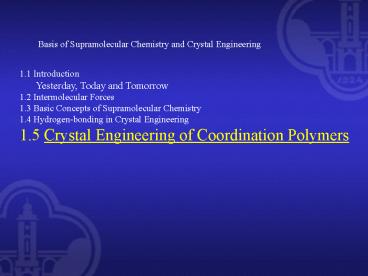1.1 Introduction - PowerPoint PPT Presentation
1 / 34
Title:
1.1 Introduction
Description:
Basis of Supramolecular Chemistry and Crystal Engineering 1.1 Introduction Yesterday, Today and Tomorrow 1.2 Intermolecular Forces 1.3 Basic Concepts of ... – PowerPoint PPT presentation
Number of Views:308
Avg rating:3.0/5.0
Title: 1.1 Introduction
1
Basis of Supramolecular Chemistry and Crystal
Engineering
1.1 Introduction Yesterday, Today and
Tomorrow 1.2 Intermolecular Forces 1.3 Basic
Concepts of Supramolecular Chemistry 1.4
Hydrogen-bonding in Crystal Engineering 1.5
Crystal Engineering of Coordination Polymers
2
1.5 Crystal Engineering of Coordination Polymers
- Important basis of coordination polymers and
supramolecules - 0-D Supramolecules
- Structural control supramolecular isomerism in
low-dimensions - 1D-3D coordination polymers
???????
3
???????????
Frameworks ??
Inorganic Zeolites
4
O.M. Yaghi, Science, 2002, 295, 469
Systematic Design of Pore Size and Functionality
in Cubic-like MOFs and Their Application in
Methane Storage
X-ray structures of the MOFs. Zn (blue
polyhedra), O (red spheres), C (black spheres).
The large yellow spheres the cavities
5
desolvation
decomposition
Thermal stable up to 400 oC
Large capacity 800-1500 mg/g
6
Zeolitic Metal-Organic Frameworks
M
?????
1
????? Zeolite nets
2
135?-145 ?
In zeolites
7
Zn(mim)2n?xsolvent-SOD Zeolite
(??)?????????d10??????????
Feature Small windows Large cavity
Topologic net
solvent accessible area 47.0
8
Zn(eim)2n?xsolvent-RHO Zeolite
void 55.4
9
????
Isotherm for N2 adsorption at 77 K (a) and MeOH
vapor adsorption at 298 K (b)
Zn(mim)2n-??SOD
Angew. Chem. Int. Ed. 2006, 45, 1557
10
Thermal Stability
Zn(mim)2n- Zeolite SOD
Zn(eim)2n- Zeolite ANA
TGAgt450 ?C
TGAgt400 ?C
Thermogravimetric Analysis
11
AgCl Hatz
Ag6Cl(atz)4(OH)6H2O8 (8)
NH3H2O
AgCl Ag2O Hatz
3-connected 4.142 net or 4-connected diamond net
12
Ag
Cl
AgCl 3.060 Å
8.5 Å
5-fold interpenetration
Void 32.7
Tetragonal I _at_ 293K (8)
13
Ag6Cl(atz)4(OH)6H2O8 (8)
dehydrate
-4H2O
Ag6Cl(atz)4(OH)2H2O8 (8)
14
AgCl 3.053, 3.070 Å
4.3 ? 10.4 Å
Tetragonal P _at_ 293K (8)
6-fold interpenetration
Void 25.2
15
Reversible structural changes
H2O
H2O
Dehydrated 4.3 ? 10.4 Å
Hydrated 7.8 ? 9.2 Å
Dynamic or Smart Porous Material
JACS, 2005, 14162
16
One-pot synthesis of triazoles Cycloaddition of
Nitriles NH3 under hydro(solvo)thermal condition
Traditional synthetic methods multi-step,
hydrazine derivative based
Angew. Chem. Int. Ed. 2004, 43, 206
17
4-connected nets based solely on square-planar
nodes
Cu(tz) Cu(mtz)
Cu(ptz)
18
Cu6(etz)6guest (12) ????????
??????
????
??-????? ??? gt 300oC
JACS 2005, 127, 5495 JACS 2008, 130, 6010
19
Cu(etz) (MAF-2) A porous material with
exceptional flexibilities and sorption properties
Flexible ethyl groups
d 1.5 Å
d lt 3.6 Å
gt 300oC
JACS 2005, 127, 5495
20
Flexible Framework
21
???????????
Traditional
Dynamic
????????,?????????? ?????????????????
22
Multimode Guest-triggered Structural
Transformations
-
P1, V 1603 Å3
N2
-
R3, V 1580 Å3
-
-
R3, V 1561 Å3
-
R3, V 1591 Å3
R3, V 1606 Å3
-
D 0.1-1.3
Im3, V 1660 Å3
23
?????????
???????/???
????/???
??????????
??????
24
Crystal Structures of MAF-2G
25
A Dynamic Porous Magnet KCo7(OH)3(ip)6(H2O)4
(ip 1,3-phenyl-dicarboxylate)
Assembling magnetic anisotropic high-spin
clusters into 3D porous network
Multifunctional Material
26
Co3 6-coordinate to 4-coordinate
N2 Sorption
Structural Change single-crystal to
single-crystal Transformation
27
Guest-induced modulation effect of magnetic
properties
1
1
frequency dependence of the ac susceptibility
Hysteresis curves the temperature-dependent
susceptibility
Incorporating magnetic properties into porous
structure!
28
??????(Secondary Building Units, SBUs)
???? ??? ??? ??? ???
4 6
6
29
???????
MOF-500
MIL-100 MIL-101
MOF-236
MOF-235
G. Férey, et al. Acc. Chem. Res., 2005, 38, 217
O. M. Yaghi, Angew. Chem. Int. Ed. 2006, 45,
2528 Inorg. Chem. 2005, 44, 2998-3000.
30
(No Transcript)
31
???????(Supermolecular Triakis Tetrahedron)
void 21.2
d 9.3 Å 8.6 Å
32
????
d 12.4 Å void 47.3 Total void 68.5
33
Dynamic Porous Materials?
Smart Materials ?
34
?????????
- ?????????,????????????????????
- ??0.3-2 nm,????????
- ????,???????(smart)
- ?????????????????(??),?????????
- ???
- ???????
- ??????
???????????































